The Butt and Pass Log Cabin Method: Expert Explain
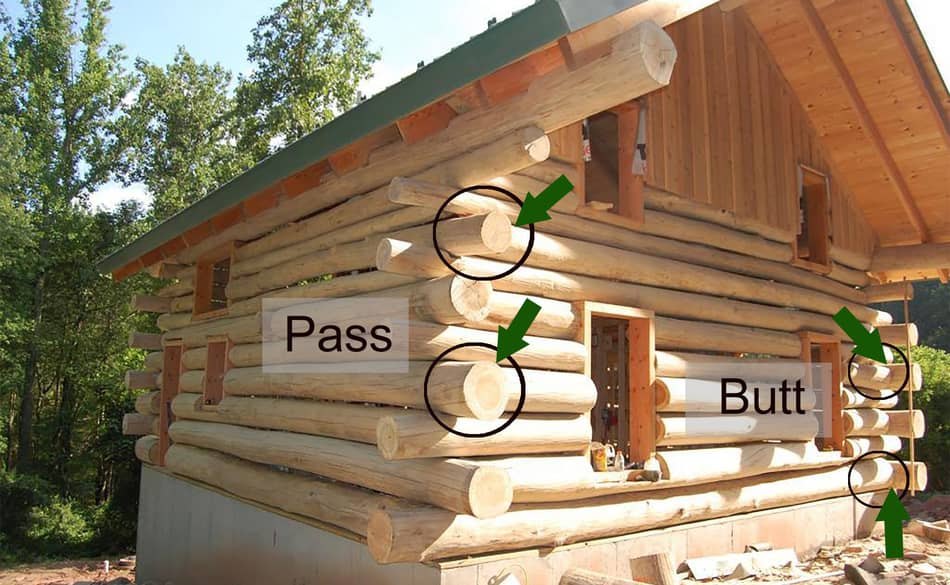
The butt and pass is a construction method used in cabin building. It’s a method for beginners with little to no experience or prior woodwork knowledge. This technique requires each log to be stacked on top of one another, at correct angles and then being pinned or fixed together. If you plan on building your log home with the butt and pass connection method, you should check the Log Home Builders Association and its inventor and follower Skip Ellsworth.
The butt and pass approach is based on the principle of simple construction and it has relatively inexpensive maintenance. But do not think that this technique does not require any skill at all. However, it is unquestionably the best option for someone who has never built a log cabin before.
Butt and Pass have been the most common method used for building log cabins since its invention in the 1970s by the already mentioned Skip Ellsworth. This method is so widespread that you for sure have seen a log cabin that was built by this technique without even knowing it. Butt and Pass method became popular because of how simple and fast it is, and even more so, because of how cheap it is to carry out.
> Get A Book: Building With Logs Here <
This article will explain in further detail what the butt and pass technique actually is, a quick summary of its history, why people use it, why you should use it, and how to build a log cabin using this approach. Therefore, if you’re interested in constructing a log cabin by using the butt and pass method, keep on reading.
Table of Contents
What is the Butt and Pass Technique?
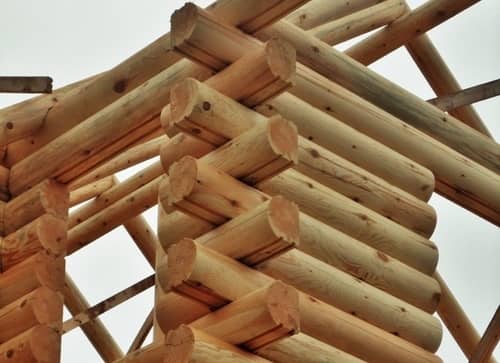
If you do not know the basics of login cabin building, our advice is to read How To Cut Logs For Log Cabin article. That will help you understand the further explanations and instructions in the following few paragraphs. When you begin building the log wall, you will see that notching a log cabin is supposed to be carried out during the construction process. While the butt and pass method isn’t precisely notching because it doesn’t need scribing, it is a close alternative for notching, so it is sometimes mistaken for it.
So what actually is it?
The butt and pass is simply a log home construction approach. More precisely, It’s a method of building cabins that employs firmly pinned corners for linking the logs firmly without notching. Each log must be put on top of the other at right angles and then pinned or secured together. This can be done with rebar (also called metal rod), pins, screws, or whatever else is available.
The logs in the image below vary in size. Some being long and some being short. The perpendicular longer log (B) lies on top of the other longer log (A), and the short log (C) meets the perpendicular longer log (B).
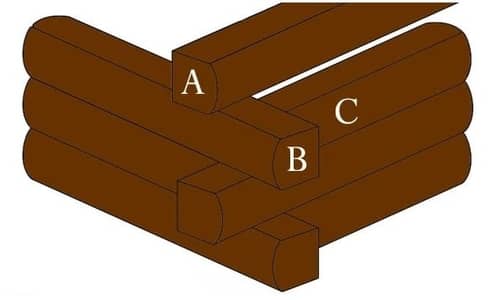
Other than with these types of logs, this process can be carried out with rounder, hand-hewn, or D-shaped logs that are common in home design.
Note! Just make sure if you are using the D-shaped log, cut a 5-10 centimeters off the underside of a 12′′ diameter log.
The Log Home Builders Association recommends using round logs because they are proven great and give the beloved traditional look. Fresh, round, and unprocessed logs are excellent. Without any milling or manufacturing procedures, your log cabin is delivered directly from the forest.
The butt and pass method has a few well-known variants. The most significant one was developed by Skip Ellsworth. He even made a course around his butt-and-pass carpentry method, teaching students how to apply it. Skip’s method entails butting and passing natural logs that are fastened and held together. This construction method has several benefits over standard notching procedures, which will be covered later in this article.
You also may be wondering about How Long Do Log Cabins Last? Expert Explain.
Who Is Butt and Pass Method For?
Homeowners that want a vintage outside look of their log home should choose the log corner section style of the butt and pass technique. With that style, every other log that is placed on each wall extends only several inches beyond the corner angle in the butt-and-pass, creating an appearance that resembles a stair or a ladder.
The butt-and-pass joint is easy to construct and produces a nice, tight fit, which we strengthen with a wooden dowel at each joint. The tight fit is very important because it ensures a long-lasting structure. Tongues are also removed from the tongue-and-groove construction from the projecting log portions to prevent moisture from accumulating.
A Short History of Butt and Pass Log Cabin Technique
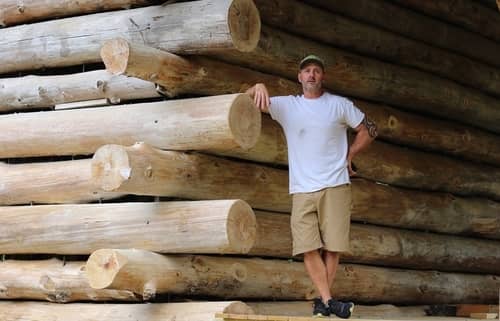
Skip Ellsworth popularized and commercialized this rustic approach in the 1970s, and since then, it gained a reputation among many log cabin professionals.
Butt and Pass is a divisive log home building style. That’s why most either love it or despise it! The concept of workmanship and notching vs. speed and expense is at the heart of the debate. Because the legacy of these cottages is barely 50 years of age, its durability is sometimes questioned. Will these log cabins be able to resist the elements of bad weather and the passage of time? We’re still waiting to see.
Why Using the Butt and Pass Technique Is Recommended?
There are several reasons why this approach is the most popular and used log home construction method. Simply said this technique provides: no notching, scribing, log preparation, or manufacturing. These characteristics can also be broken down into three categories:
- Reducing the cost of construction as compared to conventional notching processes.
- It gives confidence in non-craftspeople to construct their own log home.
- Construction of this sort can be done by one person without the support of a whole building crew.
> Get A Book: Building With Logs Here <
The following are four benefits why you should use the butt and pass technique:
- High Construction Speed– No scribing or notching is required with the butt and pass method. As a result, it’s far quicker to construct than standard log cabin notches.
- Lower Construction Costs– As a result of the increased speed, there is a budget decrease. This is owing to the low cost of equipment and the rapidity with which you can construct.
- Ease of Construction – The third, and most significant, is the benefit of easy construction this building method provides. The simplicity of construction gives novice log house builders confidence and lowers the hurdles to establishing a log home.
- Logs are inexpensive– The technique relies on the use of organically collected logs. Because the logs do not need to be milled, the cost of the logs is also significantly reduced.
Note! While many sources suggest that this construction approach is stronger and requires less maintenance than typical notches, it’s important to be aware that this technique has only been present for 50 years and there is no concrete proof that cabins last more than 50 years if done with this technique.
How to Build a Log Cabin Using the Butt and Pass Technique
By reading the article up until here, you should have a good understanding of why you should adopt the butt and pass approach, the benefits of doing so, and why thousands of other log cabin homeowners did. Some of you may wonder – how do you build a log cabin using this method? In this section, we’ll explain how to build a cabin using the butt and pass technique.
Things You Will Need
- Log home blueprints
- Cabin home wood for the external walls
- 7 1/4-inch builder’s saw
- 12-inch sliding miter saw
- Reciprocating saw
- Hammer
- Knife or chisel
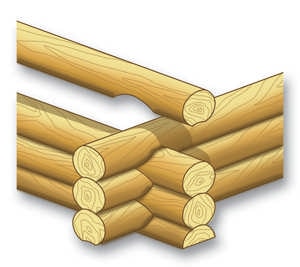
The building is the fun part! You should get your hammer, a drill, a bunch of rebar, and some motivation. Stacking logs and securing them with rebar is at the heart of this method. This technique requires the use of logs in pairs, with the pair piled on top of one another at a vertical angle and secured together.
Each pair is made up of two logs, with the tip and down end alternating (Log A and Log C). The perpendicular log (Log B) should sit on top of Log A, and the perpendicular log (Log C) should be stopped by the same Log B. This process goes on and on. Piercing and pushing rebar into the logs should be the preferred method of joining them.
The rebar should have a diameter of 14mm to 18mm and a length of up to 36 inches. To make a stronger link, try pinning through numerous layers of logs. You should pin at each corner and again about every 6 feet, depending on the length of the cabin. The wooden construction should be secured in such a way that it cannot be dismantled.

When building a log home with the butt and pass method, the first logs should be laid clockwise around the foundation. However, on your primary elevation that is usually south facing so, it doesn’t attract moss. The first log will be in the butt left position end and pass the right end. Later, when creating the wall, alternate the timbers.
To secure the ledge logs to the foundation, it’s best to use concrete piers with rebar. Starting with piers will provide a more solid base and prevent settling problems.
After the second layer of timber is in place, inspect the bottoms of the timbers to check which ones protrude beyond the corners. Avoid those in the first few layers because the carved groove will create an entrance beneath the timber, allowing moisture or bugs into the structure. If it’s impossible to avoid those, make sure to fill the spaces between the logs by caulking grooves using a caulking compound. It’s best if you can find one, especially for log cabins.
Here is an interesting video where it is shown how you can build a simple off-grid log cabin house with the butt and pass method.
For those who want to learn more, be sure to read 7 Essential Log Cabin Tools Required to Build a Log Cabin.
FAQ: People Also Ask
What are butt and pass corners?
A log house made out of butt-and-pass corner joints has the appearance of a rustic, and cozy cabin. The very first log on each level extends past the corner as the logs are laid to form the building’s exterior corners, while the log creates the other wall bumps against the first one.
Do you need permission to build a log cabin?
Wooden cabins are classified as “permitted developments,” which means they, in most cases, don’t require planning approval as long as the following is built on land that is owned by the builder. If the cabin is next to the house the cabin shouldn’t occupy more than half of the area surrounding the home.
How do log cabins stay together?
People used to build log cabins by stacking tree trunks on top of one other and overlapping the logs at the corners. By both, notching the logs at the ends and interlocking corners, constructions started becoming sturdier and that became the prevalent way of holding wood together. Those were additionally weatherproofed by putting moss or other soft material into the connections.
Final Thoughts
To conclude, if you want to create a traditional home, quickly and easily, the butt-and-pass building style is the way to go. Particularly if you have no prior experience with log cabin construction and like the look of log homes without notches. Of course, all of the advantages of not employing a notch, as listed above, come with drawbacks. It will be difficult to avoid the usage of traditional and unique corner notching, which has been used for generations.
Notching still is an excellent building approach when combined with architectural wisdom and broad overhangs that eliminate moisture dams and hard corrosion. Alternative notching procedures should definitely be explored if you have enough time, resources, and experience or patience to master a new skill.


Thank you for your sharing. I am worried that I lack creative ideas. It is your article that makes me full of hope. Thank you. But, I have a question, can you help me? https://www.binance.com/kz/register?ref=FIHEGIZ8
Your point of view caught my eye and was very interesting. Thanks. I have a question for you.
I don’t think the title of your article matches the content lol. Just kidding, mainly because I had some doubts after reading the article.